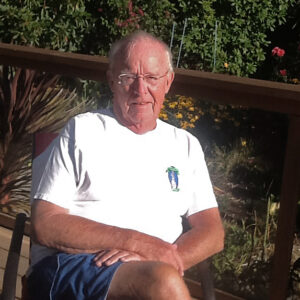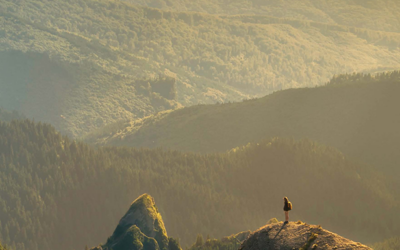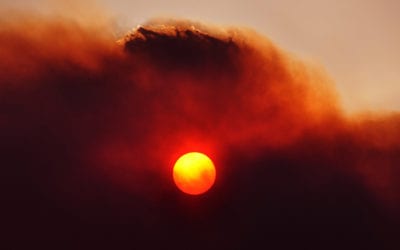Boundary Waters Canoe Area Wilderness. Photo credit Josh Hild on Unsplash..
George Stankey: Mentor, Colleague, Friend
Soul Of The Wilderness
December 2021 | Volume 27, Number 3
Just over a half century ago, passage of the Wilderness Act in the United States created a new land designation, codifying the specific meaning for wilderness as something to be protected and experienced. But what exactly was this special experience, what threatened it, and how was this experience, wilderness lands, and visitors to be managed? A few people recognized the importance of bringing science to bear on these issues, and the science of wilderness and its management was born in the 1960s. One of the pioneers of this new wilderness science, George Stankey, died peacefully on August 18, 2021, surrounded by family at his home on the Oregon coast. He was 78. George had been diagnosed with stage 4 pancreatic cancer just months before. For those who knew him, not surprisingly he departed on his own terms with dignity and grace – and maintained his humor to the end.
The undisputed father figure of the new wilderness science was Bob Lucas, one of the first scientists to study wilderness visitors in detail and the person given responsibility, in 1967, for creating and directing the first wilderness management research program at the Forest Service’s Intermountain Forest and Range Experiment Station in Missoula, Montana. Bob went on to hire or provide funding to many of the pioneering wilderness scientists of the 1960s and 1970s: Sid Frissell, Dave Lime, Larry Merriam, Steve McCool, Perry Brown, Joe Roggenbuck, and David Cole. But George Stankey was the scientist Bob chose to join him, in 1968, at the wilderness research unit in Missoula.
George was raised in Oregon, where hiking, camping, and fishing with his folks led to a love of the outdoors. He studied geography, with a special interest in recreation geography, at Oregon State University, where he received BS and MS degrees in 1965 and 1966. His master’s thesis was on recreation planning methodologies. In 1967, he started a PhD program in geography at Michigan State University. That year George responded to an outreach letter the department had received from Bob Lucas about potential work opportunities in his Forest Service research unit in St. Paul, Minnesota. By the time Bob and George had a chance to meet, Bob had accepted the wilderness research position in Missoula, Montana, with the authority to hire an additional scientist. He offered that position to George. In 1968, having completed all his graduate work other than a dissertation, George left Michigan State and moved to Missoula.
George’s first priority in Missoula was to complete his dissertation. Bob Lucas had broken new ground in his dissertation work on wilderness visitors and carrying capacity in the Quetico-Superior Canoe Country (now the Boundary Waters Canoe Area Wilderness) in northern Minnesota. George decided to extend this work, studying visitors to different wilderness areas and exploring new concepts and approaches to wilderness visitor management. He attempted to better understand the nature of high-quality wilderness experiences, what characteristics of use influence experience quality, and how to help manage for quality experiences. Recognizing that there are many different ideas about what constitutes a wilderness experience, he reasoned that experience quality should be judged – not by the average visitor – but by those he called “purists,” those visitors whose personal definitions of what is and is not desirable in wilderness most closely match the legal framework provided by the Wilderness Act. These visitors defined a high-quality wilderness experience as one with few encounters with others, in an environment where human evidence was minimal, and where it was possible to camp far from others (Stankey 1973).
George asked visitors how they would feel about encountering an increasingly large number of other groups, in this way relating satisfaction with one’s experience to level of use. He referred to widely shared preferences as norms – preferences regarding the number of encounters with other groups, appropriate methods of travel, and group size. He found that other characteristics of the groups encountered affected satisfaction more than the number of groups encountered. From the perspective of what we know today, this might seem obvious, but at the time this finding ran counter to the perception that defining carrying capacity was the key to management, and capacity was all about numbers of visitors. George found that, in addition to amount of use, visitor satisfaction was affected by method of travel, group size, and where encounters occurred (e.g., near access points versus well away from access points in the backcountry). He then described a range of management actions, in addition to restricting the number of users, that might be taken to manage wilderness use within its capacity and provided data on visitor opinions about the desirability of these actions (Stankey 1973).
One important characteristic of George’s early work was the time he spent with prominent Forest Service managers engaged in protecting wilderness, people such as Dick Joy, Bill Worf, and Tom Kovalicky. These relationships contributed to George’s deep understanding of the issues wilderness managers face, allowing him to draw important management implications from his empirical results. These relationships also contributed to George’s ability to write insightfully about wilderness management generally and to contribute to development of frameworks for helping managers think through problems. Prominent examples include the Wilderness Management textbook that George coauthored with Bob Lucas and John Hendee (Hendee et al. 1978), wilderness management classes George taught at the University of Montana and Oregon State University, and visitor use management frameworks such as the Limits of Acceptable Change (Stankey et al. 1985).

Figure 1 – George Stankey, in 1970, on a wilderness trip during his doctoral research. Courtesy of the US Forest Service.
Even more than George’s empirical work, these contributions inspired and influenced research and land management professionals around the world. Following a recent announcement on Facebook of George’s death, there have been numerous testimonials about the personal importance of George’s writings and teachings. One comment that captured George’s influence and nature came from a retired US National Park Service planner and superintendent. Noting that George had been an important mentor to many at the University of Montana in the mid-1970s, he said “his syllabus was a disorganized mess; but his class was one of my favorites.”
As the 1970s came to a close, George’s skills at networking, critical thinking, and problem-solving drew him in directions beyond wilderness in the United States. He got involved in discussions and dialogues concerning human dimensions of natural resource issues such as how to obtain and analyze meaningful public involvement. Following his work on the Forest Service Roadless Area Review and Evaluation and the Recreation Opportunity Spectrum, he received numerous requests from foreign countries for guidance concerning their emerging wilderness programs. In 1980 and 1981, he took a leave of absence from the Forest Service, lecturing in the Natural Resource Department of the Canberra College of Advanced Education in Australia and working with the New South Wales National Parks & Wildlife Service. He returned to Missoula in 1982. In 1987, he resigned from the Forest Service and took a position in Sydney, Australia, at the Kuring-gai Chase College of Advanced Education to teach and work with Australian wilderness and park managers on visitor use issues. After two years in Australia, he returned to the United States to work in the College of Forestry at Oregon State University in Corvallis.
At the time he returned, timber management in the Pacific Northwest was becoming increasingly controversial and came under escalating scrutiny, primarily around old-growth harvesting and management of endangered species, such as the marbled murrelet and the spotted owl. President Clinton, in 1994, established a multiagency Federal Ecosystem Management Assessment Team that was to examine timber and wildlife management policies, make recommendations on public land management, and build public confidence in management. The team was made up of numerous scientists representing various disciplines. George served on that team as a social scientist, along with Roger Clark from the Pacific Northwest Forest Experiment Station and Maggie Shannon from the University of Washington. The three together examined management policy and the community effects of Forest Service and Bureau of Land Management timber management in Oregon, Washington, and Northern California.

Figure 2 – George Stankey, in 2017, on the deck of his house on the Oregon coast. Photo by Jackie Stankey
The assessment was an enormous and costly effort, both financially and personally. But out of it came discussion of how adaptive management could be applied to national forest lands, at that time principally through Adaptive Management Areas designated on public lands. George rejoined Forest Service research in 1996 in Corvallis at the Pacific Northwest Research Station where he worked in the People and Natural Resources Program. With Forest Service colleagues Bernard Bormann and Roger Clark, George coauthored a seminal piece on adaptive management (Stankey et al. 2005).
George Stankey was a critical thinker who saw the big picture and could work across disciplinary boundaries. He could see how to integrate scientific data gathering with potential solutions to real world problems of natural resources management and planning. He helped define the new science of wilderness and its management. George was a respected networker, teacher, motivator, mentor, and friend to many in both the research and natural resources management community in the United States and abroad. He touched the hearts and minds of scientists and students alike. For many who knew George well, it has not been easy to lose his presence. He will be thought of often and genuinely missed.
More Information
For those interested in reading or hearing a recent interview with George or exploring his writings, the History of Wilderness Science page on the website of the Aldo Leopold Wilderness Institute has a section on Pioneering Wilderness Scientists, with a page devoted to George Stankey at https://leopold.wilderness.net/history-of-wilderness-science/pioneering-wilderness-scientists/George%20Stankey/default.php.
About the Authors
DAVID N. COLE is emeritus scientist with the Aldo Leopold Wilderness Research Institute. He retired in 2013 after a 35-year career as a wilderness scientist. Since his retirement he has been developing a History of Wilderness Science section on the Leopold Institute website, with interviews of pioneering wilderness scientists and papers documenting the history of wilderness science.
STEPHEN F. MCCOOL is a professor emeritus of wildland recreation management at the University of Montana. Steve is an active wilderness and backcountry user and accepts assignments dealing with protected area management in various areas of the world.
DAVID W. LIME is an emeritus senior research associate at the University of Minnesota and has authored or coauthored more than 250 scientific publications on a variety of issues focusing on human dimensions of natural resource management and planning.
References
Hendee, J. C., G. H. Stankey, and R. C. Lucas. 1978. Wilderness Management. Washington, DC: US Government Printing Office.
Stankey, G. H. 1973. Visitor perception of wilderness recreation carrying capacity. Research Paper INT-142. Ogden, UT: USDA Forest Service, Intermountain Research Station.
Stankey, G. H., R.N. Clark, and B. T. Bormann. 2005. Adaptive Management of Natural Resources: Theory, Concepts, and Management Institutions. General Technical Report PNW-GTR-654. Portland, OR: USDA Forest Service, Pacific Northwest Research Station.
Stankey, G. H., D. N. Cole, R. C. Lucas, W. E. Petersen, and S. S. Frissell. 1985. The Limits of Acceptable Change (LAC) System for Wilderness Planning. General Technical Report INT-176. Ogden, UT: USDA Forest Service, Intermountain Research Station.
Read Next
December 2021
In this issue of IJW, we remember George Stankey and his contributions to wilderness research and stewardship. Mark Anderson provides a synthesis of recent findings on carbon storage in old growth forests. Rosemary Evans examines prescribed burning in Britain’s moorlands. And Tobias Nickel presents a call for a standard definition of “Natural” in wilderness stewardship.
Crises of Use
As we transition to a post-pandemic society, demand for transformational, restorative, and education experiences in nature will not recede. Nature has demonstrated its diverse benefits to a greater constituency these past months, and we as advocates, scientists, and managers need to embrace the challenge that comes with a larger audience.
A Plea for a Standard Definition of “Natural” in Wilderness Stewardship
We face the challenge of applying more nuance and thought to the term ‘natural,’ the meaning of which most of us previously took for granted



